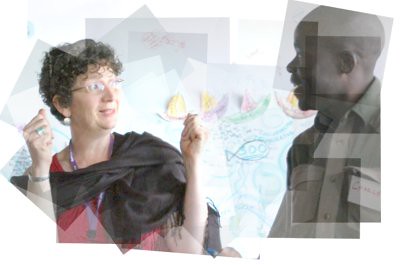
No, I’m not offering advice to Jon Stewart of the Daily Show, nor to Connan O’Brien, nor Oprah. What I’m talking about is an alternative method to boring presentations. It is called the chat show or talk show format. It brings panel presentations a step closer to life. I’m still a strong advocate for more participatory forms, but if you are forced to put something “up front,” this is an option.
First, for a full description of the method, check out this page on the Knowledge Sharing Toolkit:kstoolkit » Chat Shows
Second, read a story of this method in action from Michael Riggs.
Finally, inspired by Michael’s post, I thought I’d share the tips I had for hosting one of these little gigs. I am often asked to be the host, so here are some of the things I try to do. (Yeah, sometimes I fail!)
Re Hosting skills — I agree that a good host is really crucial, so much that I like to run practice groups with potential hosts to give them experience, have the test group offer peer feedback and switch roles (host, panelist, audience) and offer those perspectives.
The key things we have identified around the host role are: (hm, I should blog this)
- Study up on your panelists so you can give a brief introduction that focuses on th relevance of the guest to the topic at hand – not everything they have done.
- Remember, you are there to help everyone learn something and to make the panelists as successful as possible.
- Create a comfortable, welcoming context. I like to sit in chairs without a podium or table and instead have an informal coffee table (with coffee!) in front of the chairs which are arranged in a semi circle so each panelist can see each other and the host. I usually suggest the host sits in the middle to allow good eye contact.
- Think in advance of good questions that aren’t yes/no questions, and are specific enough so that the panelists don’t have to give long preambles. Questions that go right to the heart of the matter being covered.
- Use follow up questions to elicit details and specifics. Interrupt politely to do this if needed. Don’t let people ramble. It does no one any good.
- Face the panelist who is speaking. Turn your body, REALLY face them, and listen very carefully. When you are clearly listening, speakers are more willing to let you interrupt and this can be the moment to help the speaker focus.
- DO NOT promote your ideas or story. You are the INTERVIEWER, not the SUBJECT of the interview.
- Make sure everyone gets fair airtime. This does not mean EQUAL airtime, but that each person’s idea or point has been clearly presented.
- Summarize briefly during and more fully at the end.
- Allow speakers one final SHORT comment that you frame by asking a specific “wrap up” question. Don’t say “is there anything else you’d like to say.” Uh uh.
- Where culturally appropriate, use humor. I recently hosted a chat show with a “bigger than life” chat show personality and we had fun with it. It was a more informal gathering, so it was in the appropriate context.
On an unrelated note, why does the picture show up nicely right aligned in my WordPress composition page, but then show up at the top when I post? It used to work so nice until the last WP update. Sigh
Thanks for these tips Nancy – I feel much more ready to take the leap and host a chat show at the upcoming Agriknowledge Share Fair at IFAD. Just one question: does the host have to sit with the speakers? Have you tried sitting apart, standing close by or roaming? Cheers…
Jeff, I thnk the main thing is the host is engaged. You can roam, Oprah style, just so long as it is not distracting, but I would start and finish WITH the guests. Keep the connection!
Nancy, thank you so much for sharing your tips! I have recently started a chat podcast show, and I am loving it! I usually only have one guest on, plus me and my co-host. Do you have any suggestions as far as topics to chat about? I want to keep peoples attention. So far the podcast has been pretty successful with in our community. Thanks again!